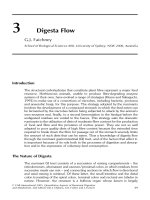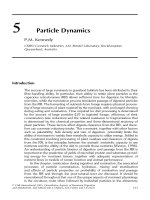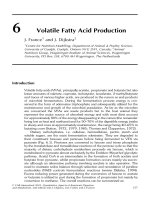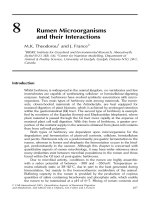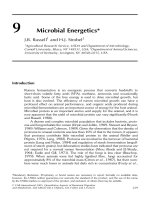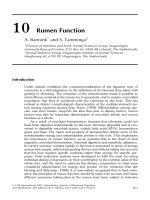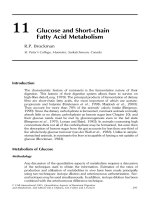Quantitative aspects of ruminant digestion and metabolism - Phần 4
Bạn đang xem bản rút gọn của tài liệu. Xem và tải ngay bản đầy đủ của tài liệu tại đây (256.59 KB, 34 trang )
5
Particle Dynamics
P.M. Kennedy
CSIRO Livestock Industries, J.M. Rendel Laboratory, Rockhampton,
Queensland, Australia
Introduction
The success of large ruminants in grassland habitats has been attributed to their
fibre-handling ability. In particular, their ability to retain plant particles in the
capacious reticulorumen (RR) allows sufficient time for digestion by fibrolytic
microbes, while the rumination process stimulates passage of digested particles
from the RR. The harvesting of nutrients from forage requires physical process-
ing of large amounts of plant material by the ruminant, with prolonged chewing
during eating and rumination. Time required for diet processing is determined
by the amount of large particles (LP) in ingested forage, efficiency of their
comminution (size reduction) and the related resistance to fragmentation that
is determined by the chemical properties and three-dimensional anatomy of
plant particles. These factors affect digesta clearance from the RR, and there-
fore can constrain voluntary intake. This constraint, together with other factors
such as palatability, bulk density and rate of digestion, potentially limits the
ability of ruminants to satisfy their metabolic capacity to utilize energy. Added to
this constraint involving processing of plant residues and clearance of digesta
from the RR, is the interplay between the animals’ metabolic capacity to use
nutrients and the ability of the diet to provide those nutrients (Weston, 1996).
An understanding of particle kinetics of digestion and passage from the RR is
important in the prediction of yields of microbial protein and substrates provid-
ing energy for ruminant tissues, together with adequate representation of
nutrient flows in models of rumen function and animal performance.
In this chapter, mastication during ingestion and rumination, the associated
processes of particle comminution, hydration, mixing and stratification
and effects of particle properties on probability of rumination and passage
from the RR and through the post-ruminal tract are discussed. It should be
remembered throughout that one of the unique aspects of ruminant physiology
is the circuitous route often followed by individual particles in the alimentary
ß CAB International 2005. Quantitative Aspects of Ruminant Digestion
and Metabolism, 2nd edition (eds J. Dijkstra, J.M. Forbes and J. France)
123
tract. This route is determined by the interplay between individual particle
properties, fermentative activities of adherent microbes, the cumulative effects
of digesta load and packing of particles within the RR and the mixing and
propulsive activities of the RR and post-ruminal tract. The stratification of
particles into a floating ‘raft’ in the dorsal sac of the RR is a feature in some
situations and is thought to be important to the preferential retention of newly
ingested particles for subsequent fermentation, and to allow enhanced passage
of aged particles that have undergone digestion.
Description of these processes, and of salient anatomical features of the
ruminant gut, are given by Reid (1984), Sutherland (1988), Poncet (1991) and
also in Chapter 3. The physiology of regurgitation has been reviewed by Ulyatt
et al. (1986).
Properties of Particles Associated with Rumination and Passage
Particle properties, especially ‘size’ because of its relative ease of measurement,
are integral to discussion of particle movements. Particle size is usually deter-
mined by wet or dry sieving techniques, using screens of differing aperture and
allowing a sieving time sufficient for all particles to have an opportunity to pass
the screen. Particle size is an imprecise term and lack of standardization in its
measurement with respect to equipment, sieving time, degree of agitation and
mass of particles applied to the sieves can markedly influence the result. Despite
this, many methods yield comparable information, although some result in
estimates of enhanced median particle size (Murphy and Zhu, 1997). At least a
part of the variation between methods results from differences in opportunity for
‘end-on’ approach of particles to the screen, which allows passage of some
particles through screens on the basis of their diameter, rather than length that is
the prime determinant of passage in most techniques. The relation of particle
length or diameter to the aperture of retaining screen may differ depending on
the source of the particles (e.g. faeces vs. RR, McLeod et al., 1990). When
reference is made in this review to data derived by sieving, the aperture of the
screen that retains the particles in question is termed ‘particle size’. More recent
methods that offer speed and reliability use a simple separator with screens
(Lammers et al., 1996), microscopic image analysis (Luginbuhl et al., 1984)
or laser diffraction (Olaisen et al., 2001). Shape information can be obtained
using the latter two methods, but not from sieving methods. Classification of
particles by size gives no information on the shape (with exceptions noted
above), chemical composition or origin of the particles and consequently may
be of limited use in the description of pools of uniform kinetic behaviour in the
RR. As discussed below, the physical configuration and proportions of plant
tissues, principally of vascular structures, will determine the patterns of fragmen-
tation and the shape and rate of digestion of daughter particles (see also Kennedy
and Doyle, 1993). There is also heterogeneity of approaches for summary
statistics (Kennedy, 1984; Kennedy and Doyle, 1993).
It was recognized early that functional specific gravity (FSG) and size of
particles were interrelated and both influenced particle dynamics in ruminants
124 P.M. Kennedy
(King and Moore, 1957; Lechner-Doll et al., 1991). However, measurement
of FSG, which includes contributions from gas and fluid components in internal
inter- and intracellular spaces as well as from plant structural material, requires
maintenance during measurement of fermentative activities of microbes asso-
ciated with particles. This difficulty has resulted in only particle size being
measured in many experiments, and accordingly in an incomplete description
of factors affecting particle movements.
In this review, where reference is made to LP, medium particles (MP), small
particles (SP), generally these are defined as particles retained on a screen of
1.18 or 1.0 mm aperture (LP), those passing a 1.18 or 1 mm but retained on a
0.5 or 0.6 mm screen (MP) and those passing a 0.5 or 0.6 mm screen but
retained on a screen of 0:15À0:05 mm (SP). Fine particles (FP) are those
passing the smallest screen. These are indicative sizes, and may differ some-
what between experiments. In much of the literature, division of the particle
spectrum is made into large and small only, to designate particle pools that can
be cleared from the RR with low and moderate to high probability, respectively.
Accordingly with this division, the small particle pool includes MP, SP and FP
using the definitions above. In this review when reference is made to these
studies, the ‘small’ particles will be referred to as non-LP.
Ingestion and Effects of Mastication
Time required for ingestive chewing comprises about 40% of total chewing
time dedicated to ingestion and rumination (see Wilson and Kennedy, 1996)
and is related to diet fibrosity and maturity (Weston, 1985) and therefore to
degree of diet selection. The proportions of leaf and stem of available forage,
and their respective physical and mechanical properties, affect the ability of
animals to prehend and harvest their diets (Ulyatt et al., 1986; Wright and
Illius, 1995). The particle comminution that accompanies mastication and
insalivation of the feed bolus required for comfortable swallowing is a secondary
effect, but it does compromise structural integrity of the leaf and stem com-
ponents by removal of cuticle, crushing and separation of vascular bundles
and other plant tissues, and release of plant cell contents (Ulyatt et al., 1986;
Wilson and Kennedy, 1996). Nevertheless, for stems of different lengths,
chewing time may be related to length of feed, and the resultant particle
distribution of the swallowed bolus may be similar or even of smaller
particle size for forage of longer chop length (Gherardi et al., 1992; Pan
et al., 2003). These physical changes aid subsequent colonization of the
ingested material by fibrolytic microbes when material reaches the rumen
(Pond et al., 1984; Pan et al., 2003), while not necessarily increasing rate of
digestion (Beauchemin, 1992), with the possible exception of tropical grasses
(Poppi et al., 1981a).
A comparison of susceptibility to ingestive comminution of different
forages may be made using a ‘chewing efficiency index’ (CI), calculated as:
CI ¼ LP
ingested
=LP
feed
(5:1)
Particle Dynamics 125
where LP
ingested
is the proportion of LP in the ingested bolus and LP
feed
is the
proportion of LP in the feed.
Dryden et al. (1995) stated that values for this index for sheep and cattle,
using a 1 mm screen to define LP, are usually between 35% and 55% except
for a value of 26% for cattle consuming annual ryegrass. With sheep and
cattle fed high-quality temperate grass forages, at least 40% of LP are
comminuted (CI of 60%) during eating (Gill et al., 1966; Reid et al., 1979;
Ulyatt, 1983; Domingue et al., 1991) compared with only 9–39% of LP
in tropical forages (Poppi et al., 1981b; Pond et al., 1984; McLeod, 1986).
However, Lee and Pearce (1984) concluded that there is no simple relationship
between the degree of size reduction and their fibre content, perhaps
because the former is also related to level of feed intake (Luginbuhl et al.,
1989a). Ulyatt et al. (1986) suggested that fresh diets and those of high
nutritive value are chewed more effectively than dry ones, or those of lower
nutritive value. In contrast, Burns et al. (1997) reported that advancing
switch grass maturity was associated with reduced LP content of the ingested
bolus. Selection of a larger screen to define LP may yield a different ranking
when forages are compared (see Grenet, 1989). Sauvant et al. (1996)
proposed the following relationship between proportions of LP in the ingested
bolus and the feed:
LP
ingested
¼ 1:21=(1 þ 1:14=LP
feed
)(5:2)
This relationship closely described data from ground forages, but there
was large variation for long forage. The relationship did not provide a good fit
for data of Gherardi et al. (1992) for sheep fed diets in which particle
size of wheat hay was varied between 4 and 101 mm (Fig. 5.1). When a screen
of 2.36 mm aperture was used instead of one of 1.18 mm to define LP,
an equation of the same form as Eq. (5.2) provided an adequate fit.
This illustrates the utility of the mathematical function employed by Sauvant
et al. (1996) and at the same time provides a caution concerning the
appropriate definition of LP.
The mean particle size in the swallowed bolus declines with time after the
start of meal eating (Gill et al., 1966). This decline is associated with an
increase in jaw movements per bolus, larger boluses and less rapid swallowing
of boluses as the meal progresses. Differences between animals in average
particle size of swallowed hay boluses have been observed (Gill et al., 1966;
Lee and Pearce, 1984; Ulyatt et al., 1986; Gherardi et al., 1992). Rate of
chewing during eating in cattle is slower and is less effective in reducing particle
size than in sheep (Ulyatt et al., 1986).
Newly ingested boluses commonly disintegrate in the ventral rumen or the
caudal ventral blind sac after 5–15 min, while ruminated boluses break up more
readily (Reid, 1984). Individual particles then become susceptible to the various
forces that determine their location in the RR and their likelihood of passage
from this compartment as described later.
126 P.M. Kennedy
Fragmentation patterns and role of plant anatomy
During ingestive mastication, plant tissues fragment into particle size categories
in a stochastic process (Kennedy et al., 1997), according to constraints pro-
vided by epidermal and vascular structures (Fig. 5.2).
Rate of intake of legumes was higher than for grasses and the extent of size
reduction of petioles and stems was correspondingly less (Wilman et al., 1996).
The greater ease of breakdown of lucerne than of ryegrass has been attributed
to differences in fibre content and three-dimensional structure of the lignified
supportive tissues, which in the case of lucerne are central xylem tissues
compared to the scattered arrangements in ryegrass (Grenet, 1989). For
temperate grasses, the fragments that result are long vascular strands, whereas
leaf fragments from tropical species generally remain in blocks of vascular
bundles due to girder-like structures in the latter (see Wilson et al., 1989b) but
with ready detachment of cuticle (Pond et al., 1984). The characteristics that
contributed to greater leaf rigidity in the tropical grass were cross-sectional
area of thick-walled tissues, a higher vascular bundle frequency per unit
leaf width, and lesser amount of densely packed mesophyll (Wilson et al.,
1989b). Legume leaves readily fragment due to their lack of girder structures
(Wilson and Kennedy, 1996). The degree of longitudinal vs. lateral splitting
0
0.1
0.2
0.3
0.4
0.5
0.6
0 0.2 0.4 0.6 0.8 1
Proportion of LP in feed
Proportion of LP in ingested bolus
Fig. 5.1. Relationship (solid line) proposed by Sauvant et al. (1996) to describe change of large
particle content (LP, determined by retention on a screen of aperture 1.18 mm) of the ingested
bolus with that of the feed, together with data of Gherardi et al. (1992) from sheep fed five diets of
wheaten hay chopped to lengths from 4 to 101 mm (
&
). When a screen of 2.36 mm aperture was
used to define LP, the latter data (
*
) was described by an equation of the same form as proposed
by Sauvant et al. (1996): y ¼ 0.212/(1 þ 0.419/x).
Particle Dynamics 127
during chewing of petioles, sheaths and leaf blades can be related to the
abundance, thickness and orientation of vascular bundles (Mtengeti et al.,
1995). For example, Wilson et al. (1989a) reported that ingestive chewing
reduced both length and width of fresh leaf blades of a tropical grass (Panicum
maximum) to a greater extent than for a temperate grass (Lolium multi-
florum). Reductions in length for the tropical grass were approximately nine-
vs. fivefold for temperate leaf, whereas mean width was reduced approxi-
mately five- and twofold. Wilson et al. (1989a,b) and Wilman and Moghaddam
(1998) found that tropical grasses were chewed into particles ‘somewhat
smaller’ than the temperate ones, apparently involving slower eating. After
chewing, particles of tropical stem were much larger than corresponding
leaf particles; 6–10% of total cell wall area was exposed on the outside of
chewed particles of legume leaflets and grass leaf blades and sheaths, whereas
stem fragments were larger, and only 3–4% of cell wall area was exposed
(Wilman and Moghaddam, 1998).
Ingestive chewing
and initial digestion
Rumination effort/time
Plant fraction
Large
particles
Small particles
Fines
(A) Leaf
(a) Tropical
(b) Temperate
(c) Legume
(B) Stem
(d) Grass
(e) Legume
Mes
Mes
Mes, phl
Epi, coll
Central
pith
Epi, mes, coll
Phl, phl fibre
Central pith
Multi VB
composites
Short VB
pieces
Midrib,
main laterals
Long isolated
VBs
Long multi
VB slithers
of ring
Long
slithers of
xylem ring
Short VB
pieces
Short multi
VB slithers
Short xylem
pieces
Short
slithers of
xylem ring
Minor veins
Fig. 5.2. Conceptual representation of the breakdown process of (A) leaves of tropical
and temperate grasses and of legumes, and (B) mature stems of grass and legume, during
eating and initial (0–6 h) digestion in the rumen to ‘fines’ or large particles, and subsequent
breakdown by rumination to SP. Width of lines approximately represents relative proportions
of each fraction. Black in stem ¼ lignified ring; mes, mesophyll; phl, phloem; epi, epidermal
fragments; coll, collenchyma; VB, vascular bundle. Reproduced from the Australian Journal
of Agricultural Research 47 (Wilson and Kennedy, 1996) with permission of CSIRO
Publishing.
128 P.M. Kennedy
Rumination and Comminution
Chewing behaviour
Duration of rumination increases with dietary intake and fibre content to
a maximum of at least 12 h/day (Weston et al., 1989), although values of
10 h/day for animals at high intake of forage of low feeding value are more
common (Dulphy et al., 1980). Coleman et al. (2003) reported a close
relationship between intake constraint (see Weston, 1996) and ruminating
time in goats. Chewing rates during rumination vary with type of animal and
forage (Dulphy et al., 1980; Weston et al., 1989). In contrast to comminution
during eating, it has been proposed that rumination has the primary function of
facilitating clearance of digested particles from the RR by reduction of particle
size and positioning of particles in ‘zones of escape’ (adjacent to the reticulo-
omasal orifice), where there is an enhanced likelihood of onward passage
(Ulyatt et al., 1986; Waghorn et al., 1986; Ellis et al., 1999). However,
there is evidence that the stimulus to outflow of particles from the RR that
are ‘aged’ (having been fermented and comminuted) is less during rumination
than during eating (Girard, 1990; Das and Singh, 1999). Reasons for this may
include: (i) increased salivary input during eating; combined with (ii) availability
and amounts of ‘aged’, digested particles with high propensity for onward
passage; and (iii) force, frequency and duration of contractions of the RR in
relation to opening of the reticulo-omasal orifice.
With the exceptions of legume leaf which may be quite fragile (Wilson and
Kennedy, 1996) and of very highly digestible forage (Grenet, 1989), most LP
present in the RR appear to undergo comminution during ruminative mastica-
tion rather than by breakdown through direct microbial action or by friction
against other particles during compression of the digesta mass caused by
contractions of the RR (see Kennedy, 1985; Ulyatt et al., 1986; McLeod
and Minson, 1988; Kennedy and Doyle, 1993). This conclusion applies to
reduction in particle length of LP, but less so to width which may be substan-
tially reduced during microbial digestion by splitting between vascular bundles
(Wilson et al., 1989a,b). Non-LP are also subjected to comminution during
rumination, but this occurs in competition with increasing probability of
passage as size decreases. Among particles in the RR from coastal Bermuda
grass categorized as non-LP, passage rates may vary by a factor of 2, and
probability of comminution may exceed that of passage for particles retained
on screens of 0.3 to 1 mm (Ellis et al., 1999). In that study, leaf was twice as
likely as stem to either pass from the RR or be comminuted at equivalent
particle size, thus illustrating the heterogeneity within pools defined by sieving
techniques that do not distinguish tissue type.
For particles containing vascular tissue, there may be a size below which
particles are not comminuted. Smith et al. (1983) found little comminution in
orchard grass particles of size below 0.2 mm. In agreement, Jarrige et al.
(1973) reported that time spent ruminating sharply increased when diet
Particle Dynamics 129
particle size increased from 0.2 to 1.0 mm. The effectiveness of rumination
in comminution of very small particles may depend on the presence of
fractures that may be propagated by further chewing (Kelly and Sinclair,
1989). This suggestion needs further elaboration in relation to plant anatomical
structures.
Large particle dynamics
In cattle, estimates of the proportion of ingested LP comminuted by rumination
are between 40% and 90% (Ulyatt et al., 1986), 70–84% (Suzuki, 2001) and
90% (Kennedy, 1985). The efficiency of rumination (per hour of chewing)
increases with feed intake and LP content of the RR (Faichney, 1990; Bernard
et al., 2000). Within a cycle, efficiency is a function of: (i) the ease with which
particles are transported to the mouth during regurgitation and the attendant
selection of LP requiring comminution; (ii) efficiency of locating particles
between the occlusal surfaces of the teeth; (iii) physical properties of particles,
especially the inherent resistance to fracture of particles; (iv) the particle size
distribution of the swallowed bolus; and (v) time spent chewing.
Rates of breakdown of LP in cattle have been estimated by measurement of
LP load by removal of digesta from the RR through a fistula. When frequent
feeding is practised to promote steady-state kinetics, a single measurement of
LP pool size is required, whereas when feed is available for a restricted period,
measurement of the subsequent decline in LP pool in the RR requires two
measurements (see Kennedy and Doyle, 1993). Other methods involve collec-
tion of bolus traffic from an oesophageal fistula during rumination, or using
marker techniques. In a collation of data from a variety of sources and methods,
Kennedy and Doyle (1993) found rates of LP breakdown through comminution
plus digestion of 5–29% per hour for forages, with values for sheep tending to
be 30% greater than for cattle. This difference is associated with higher chew-
ing rates during rumination in sheep than in cattle (80–100 vs. 40–60 chews
per min; Ulyatt et al., 1986), but it is not clear if differences in mastication
efficiency per se are involved. Pertinent studies employing plastic particles
showed that 10-mm particles were comminuted at rates of 2–6% per hour
for both sheep and cattle (Lechner-Doll et al., 1991), indicative of similar
mastication efficiency. It was noteworthy that, while pregnancy and lactation
affected intake and passage rate of plastic particles, comminution rate of
10-mm particles was constant at about 6% per hour in sheep (Kaske and
Groth, 1997). Whole maize grains that escape ingestive chewing apparently
are not available for rumination and pass intact from the RR (Ewing et al.,
1986). Leaf is not always comminuted at a faster rate than the corresponding
stem, but with cattle consuming coastal Bermuda grass, the difference in rate
was substantial (Kennedy and Doyle, 1993). More recent data for that diet
confirmed that ruminative comminution occurred at 27% per hour for leaf
particles retained on a 3 mm screen, compared to only 12% per hour for
equivalent stem particles (Ellis et al., 1999).
130 P.M. Kennedy
Bolus traffic
Regurgitated boluses appear to be derived from the ventral or middle parts of
the reticulum of sheep, although it has been suggested that the site of origin in
cattle may be the dorsal reticulum or cranial sac (Ulyatt et al., 1986; Luginbuhl
et al., 1989b; Suzuki, 2001). In most studies, the ruminated bolus in cattle was
found to contain a lower proportion of LP than in the dorsal sac, from where
the bolus material was thought to originate (Ulyatt et al., 1986; Suzuki, 2001).
Kennedy (1985) reported a contrary result but explanation may lie in the
non-exhaustive sieving technique used.
The regurgitated (‘up’) bolus is followed within a second by swallowing of an
unchewed (‘tail’) bolus that is depleted of LP. After chewing for approximately
1 min, the ‘down’ bolus is swallowed and the comminuted material deposited in
the anterior rumen, in proximity to the reticulo-omasal orifice. Some material is
usually swallowed before the end of the cycle; thus the ‘down’ bolus comprises
two parts. A conceptual representation of the time course of particles and LP in
the mouth during a rumination cycle is shown in Fig. 5.3. The ‘up’ bolus may
vary in sheep from 54 g wet weight for fresh herbages to 74 g for chopped
forages (Ulyatt et al., 1986) and values of 750–824 g were reported for cattle
given chopped forages (Kennedy, 1985).
In cattle, as a result of swallowing the ‘tail’ bolus, LP in the retained bolus
was enhanced by 30–47% (Chai et al., 1984; Kennedy, 1985), 15% (Suzuki,
2001) and 8–18% in sheep (Ulyatt et al., 1986). Of LP retained in the mouth
after passage of the ‘tail’ bolus, 57–86% was reduced during a rumination cycle
in cattle (Chai et al., 1984; Kennedy, 1985; Suzuki, 2001) and 39–65% for
sheep (Ulyatt et al., 1986).
Specific fragility (SF) during rumination describes the efficiency of LP
comminution of the ‘retained’ bolus and is calculated as:
SF ¼ LP
comminuted
=(chews  LP
retained
)(5:3)
where LP
comminuted
denotes LP comminuted in one cycle of rumination, chews
is the number of chews per rumination cycle and LP
retained
is the quantity of LP
in the retained bolus at the start of chewing.
SF is affected by time after feeding, with values at 16 h twice those at 4 h
after feeding for cattle fed brome grass and lucerne chaff (Chai et al., 1984).
This increased SF with time after feeding may be attributable to the digestive
weakening, or to changes with time of leaf and stem proportions aspirated to
the mouth in the ‘up’ bolus. Forage effects are important; SF of brome grass
was 50% higher than for lucerne, resulting in 21–36% more LP being
comminuted per chew at 16 h after feeding (Chai et al., 1984). Data of Suzuki
(2001) for cattle fed orchard grass and timothy hay show moderate increases
(35–44%) in SF with time post-feeding, attributable to decreases of about 20%
in shearing energy of regurgitated stem. In that study, shearing energy of stem
was two to three times that of leaf and the majority of regurgitated LP was of
stem origin. Accordingly, the proportion of stem particles would largely
Particle Dynamics 131
determine the comminution effort required. Chai et al. (1984) and Kennedy
(1985) observed a close relationship of SF with number of chews per cycle,
which led to the suggestion that cycle length during rumination was determined
by the relative extent of LP comminution. The data of Suzuki (2001) for low-
and high-quality grasses are consistent with this concept.
LP comminution and resultant particle distribution
Description of the degree of comminution during rumination to daughter pools
of different particle sizes is poorly defined, to the detriment of efforts to model
particle kinetics (Faichney et al., 1989). The chemical and anatomical deter-
minants of rigidity and brittleness of plant fractions need elucidation (Akin,
1989; Wilson et al., 1989a,b) as does the role of the rumen microbes in
digestion and weakening of fibrous plant residues and the resulting impact on
fragmentation patterns.
Ueda et al. (2001) showed in sheep that comminution from the rumen MP
pool was responsible for entry of 2.3 times as much indigestible DM into the SP
pool compared to the direct entry to the SP pool from the LP comminution.
Conversely, MP comminution was responsible for only 15% of entry into the
FP pool, whereas the amounts from LP and SP pools were 46% and 40%,
respectively (Fig. 5.4). In experiments reliant on adhesion of external markers
to mark defined particle pools, migration of marker may bias accuracy of
estimates of particle movements; application of markers using competitive
10 20 30 40 50 60 70
−10
0
0
5
10
20
30
25
15
'Up' bolus
'Tail' bolus
Intermediate 'down' bolus LP in mouth
Total particles in mouth
Final 'down' bolus
Time of chewing of rumination bolus (s)
Large particles in mouth (g)
0
10
20
30
40
50
60
Total particles in mouth (g)
Fig. 5.3. Depiction of changes in large (solid line) and total particle (interrupted line)
content of bolus in the mouth of cattle during ruminative chewing vs. time of chewing.
132 P.M. Kennedy
binding is now considered the optimal method (see Worley et al., 2002), but
marker migration may still occur (Hristov et al., 2003). Data of Ueda et al.
(2001) were derived using markers that had been applied by a soak and wash
method, which should have reduced marker migration.
Information on net changes of particle proportions during bolus traffic was
obtained by Kennedy (1985 and unpublished results) for steers fed four dried
forages. The majority of LP in the ‘up’ bolus were comminuted after one
rumination cycle mainly to MP (57–72% by weight), with the remainder
appearing in SP (18–30%) and FP (6–21%) fractions in the ‘down’ bolus.
A greater proportion (50%) of LP was comminuted to the MP pool between
4 and 16 h post-feeding, than occurred between 16 and 24 h (17–25%). In
another study with steers given separated leaf and stem fractions of Lolium and
Medicago, McLeod (1986) found that 34–40% of comminuted LP appeared in
the MP pool, while 19–41% and 13–52% appeared in the SP and FP pools.
Leaf of Lolium fragmented more to FP than was the case for the other three
diets and therefore the potential clearance rate from the RR might be expected
to be greater (see later). Such studies of net changes in particle size fractions of
boluses do not account for comminution of MP and SP initially present in the
retained bolus, i.e. changes in the non-LP pools are attributed solely to input of
material from LP fragmentation, unless particles are also marked to determine
gross movements between particle pools.
The vascular origin of non-LP produced following rumination indicates the
obvious predominance of residual vascular tissue in leaf and stem fragments in
the RR. This conclusion differs from the situation on ingestion, which results in
more digestible tissue, notably mesophyll in the non-LP. In seeking more
quantitative definition of patterns of LP comminution, sampling of bolus traffic
during rumination has yielded some insights, but has rarely been accompanied
by anatomical characterization of LP that would have facilitated a mechanistic
explanation of fragmentation patterns. In one of the few relevant studies, Kelly
and Sinclair (1989) concluded after examination of ‘up’ and ‘down’ boluses in
MP
?
LP
SP
FP
Fig. 5.4. Diagram of RR pools and flows of indigestible dry matter calculated from Ueda et al.
(2001). Pools are shown with size in proportion to content of indigestible dry matter, and width of
arrows connecting pools are in proportion to daily flows of indigestible dry matter. Biases caused
by increase in potential digestibility due to comminution per se could not be assessed. LP, MP, SP
and FP designate large, medium, small and fine particle pools, respectively.
Particle Dynamics 133
sheep that all plant components (leaf, stalk, sheath and cuticle) were broken
down at a similar rate for five forage diets. A more accurate evaluation of
fragmentation patterns is possible when particle categories are identified using
external markers, but it is important that appropriate preparation techniques
are used to ensure strong attachment of markers to particles (Bernard and
Doreau, 2000). Using markers, Suzuki (2001) identified leaf and stem
components of ruminated boluses in cattle fed orchard grass. The data showed
that the ratio of stem:leaf in the ‘up’ bolus progressively increased from about
38:45 at 4–8 h after feeding, to be about 60:35 at 20–24 h. Thus, differences
in ruminative comminution rates of leaf and stem may arise from changes in
availability of these fractions for rumination with time after feeding, in addition
to differences in SF and fragmentation patterns.
Occurrence of substantial breakdown of LP directly to SP, thus bypassing
the MP pool, was indirectly supported by evidence of similarity between LP
and SP in respect of fibre:lignin ratio and digestible fibre patterns (Waghorn
et al., 1986; McLeod et al., 1990) and also by particle distributions after
ruminal digestion of forages in situ (Nocek and Kohn, 1988). However,
because the input of particles to these pools during ingestive mastication
is from different and more digestible plant tissues than is the case during
rumination, it is probable that the chemical composition of particle fractions
cannot be used unequivocally to support conclusions about parent pools. For
example, during rumination, the smallest particles are likely to be pieces or
slithers of vascular bundle or xylem ring, in contrast to fines derived from initial
chewing, which are likely to be derived from mesophyll, epithelial and pith cells
(Fig. 5.2).
In order to clarify factors affecting degree of comminution, we require
more studies in vivo using markers to trace the fate of defined particle groups
(e.g. Ellis et al., 1999; Ueda et al., 2001) and in vitro employing bench-top
equipment to mimic chewing and fragmentation patterns applicable to the
in vivo situation. Elucidation of different patterns of fragmentation will require
description of the plant tissue of origin and composition of bolus material
retained in the mouth prior to ruminative chewing.
Microbial colonization and weakening of particles
Attachment of fibrolytic bacteria to ingested particles occurs within 10 min,
followed by bacterial growth and initiation of digestion (Koike et al., 2003).
Yang et al. (2001) and Rodriquez et al. (2003) found quadratic increases in
microbial biomass attached to ruminal particles as their size decreased to those
retained on screens of 0.15 and 0.08 mm apertures, respectively. The high
proportion of bacteria associated with the smallest particles is likely to be
caused by the predominance of highly digestible plant tissue resulting from
direct inputs from the diet (see Rinne et al., 2002; also Fig. 5.2); smaller
particles have increased surface area for microbial attachment (Pond et al.,
1984; Pan et al., 2003). This suggestion is in accord with calculations by
Wilson and Hatfield (1997) that indicate that accessibility by fibrolytic bacteria
134 P.M. Kennedy
decreases as particle size increases, partly owing to reduced opportunity of
infiltration into cell interiors through open lumens of cells with chewed ends.
Accordingly, the efficiency of microbial synthesis will be directly related to the
rate of passage from the RR of the particle material to which the bacteria are
attached (Isaacson et al., 1975), and their microbial load determined by extent
of fermentation and tissue origin of the particles.
It has been generally assumed that microbial digestion does not significantly
affect particle comminution (Ulyatt et al., 1986), but there is evidence that the
fungi in the RR are especially effective in the disruption and weakening of LP
(Fonty et al., 1999). Moreover, there is evidence that weakening of particles
during ruminal fermentation occurs, as illustrated by reduction in grinding
energy of chopped dietary material with time of exposure to in situ ruminal
incubation (Fig. 5.5). In another study, time of immersion in the rumen required
to halve initial strength (load to fracture) for ryegrass leaf, hay stem and barley
straw stem was measured to be 18, 35 and 60 h, respectively; furthermore,
these times were well related to the total chewing effort observed for each diet
(Evans et al., 1974). Rate of LP comminution, simulated in bench-top artificial
masticators was increased by ruminal digestion (McLeod, 1986; Kennedy
et al., 1997).
During digestion of temperate grass, width reduction of the chewed LP was
faster than in a tropical grass because the straight-walled intercostal cells of the
epidermis were easily separated allowing the epidermis to split, whereas the
sinuous walls of tropical grass were resistant to splitting (Wilson et al., 1989a).
The linkage of epidermis to vascular bundles via thick-walled bundle sheath cells
0
100
200
300
400
0 50 100 150
Incubation time in sacco (h)
Grinding energy (kJ/g)
Fig. 5.5. Grinding energy of particles of dietary material recovered from dacron bags after
various incubation times in the reticulorumen when cattle were fed the same hay diet of either
dolichos (
&
), verano (
*
), pangola (
~
) or sorghum (
^
) (data of Kennedy et al., 1993).
Particle Dynamics 135


